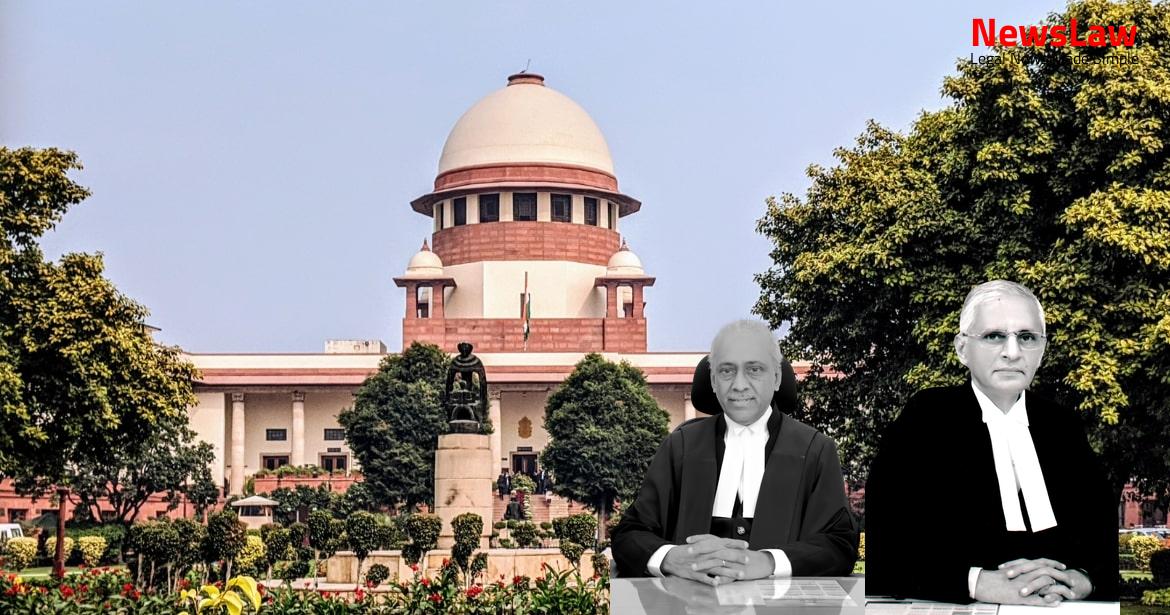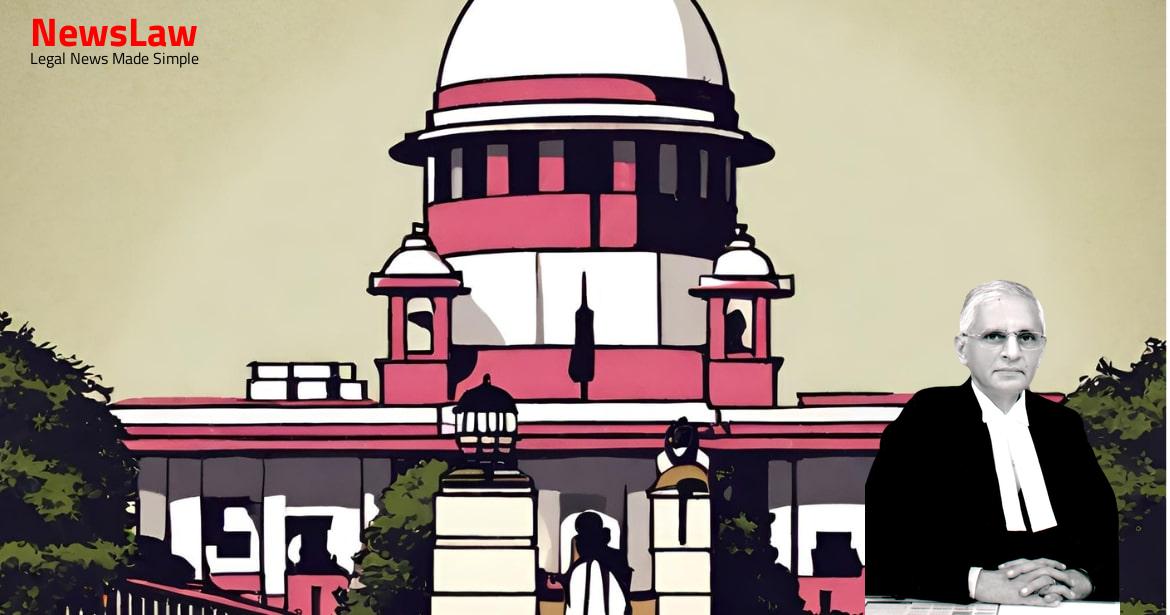Explore a detailed examination of a recent court case focusing on the analysis of compliance with exemption orders. The court’s legal scrutiny delves into the statutory powers of competent authorities and the implications of failing to adhere to exemption conditions. Uncover key insights and nuances in this informative blog post.
Facts
- The Additional Commissioner, Konkan Division, Mumbai issued a ‘No Objection Certificate’ acknowledging the handover of seven tenements despite being aware that construction had been raised on only one plot.
- The Act empowers authorities to withdraw exemption if there is a breach of conditions, as affirmed by the appellate authority.
- Respondent no.1 did not have statutory authority under the Act to levy the demand, as per Sections 20 and 21 of the Act.
- Exemption was originally granted for raising construction over two plots, CTS No 261 and CTS No 245, on 02.03.1988.
- As per Section 38(4) of the Act, the appellant could impose fines, order imprisonment, or both for non-compliance.
- The appellant is contesting the High Court’s decision affirming the demand of Rs. 51,97,196/- by respondent No.1 for failing to handover seven tenements as required under the conditions of exemption.
- In lieu of handing over seven tenements, the appellant was required to surrender 20 per cent of the constructed area to government nominees.
Also Read: Analysis of Intent in Fatal Assault Case
Arguments
- The appellant cannot evade liability by claiming that the responsibility for payment lay solely with the respondent.
- The exemption under the Act applied to two plots collectively, not just one.
- The appellant cannot argue that the original exemption conditions did not apply due to construction being on only one plot.
- Reference to the case of Naraindas Indurkhya vs The State of Madhya Pradesh and Others, (1974) 4 SCC 788.
- The appellant’s objections regarding the ‘No Objection Certificate’ post-dating a specific judgment were not valid.
- Enforcement of a 5% limit for handing over tenements to government nominees was permissible according to the authorities.
- The appellant’s transfer of development rights to other respondents was in violation of Clause 13 of the exemption order.
- Direct communication with the responsible respondents regarding breaches and liabilities had taken place.
- The demand on the appellant was argued to be beyond the Act’s provisions and therefore should be rejected.
- The no objection certificate indicated that some tenements were yet to be handed over, contradicting the appellant’s claim.
- The appellant applied for exemption under a power of attorney from the land owner.
- The appellant agreed in writing to purchase seven tenements or pay their market value.
- The building plans were submitted under the appellant’s signature.
- Reference to the case of Nargis Jal Haradhvala vs State of Maharashtra and ors. (2015) 4 SCC 259 was made.
- The submission for a cap of 5% tenements was discussed in relation to M/s Shantistar Builders case.
- Interpretation of M/s Shantistar Builders case as prospective in nature was mentioned, following the Mumbai High Court decision.
Also Read: Ensuring Fair and Thorough Police Investigations: A Legal Perspective
Analysis
- The power given under Section 20 is to the State Government, not the competent authority, to exempt land.
- The permission to commence construction was issued in the appellant’s name on 28.02.1989.
- Section 21 confers power to the competent authority to declare land not to be excess for Chapter III purposes.
- If conditions of exemption are breached, the State Government can withdraw the exemption order after due representation.
- A corrigendum issued on 29.12.1988 increased construction area, but the appellant informed authorities late in 2005.
- The appellant failed to hand over the remaining seven tenements, leading to the demand for market value in 2005.
- The appellate authority found the appellant responsible for fulfilling exemption conditions.
- Disputes between the appellant and respondents 2-4 are deemed private and do not affect the appellant’s liability under the exemption order.
- The competent authority’s power is limited by statutory jurisdiction and cannot be expanded by the appellant’s undertakings.
- Interpretation of Sections 20 and 21 shows the authority’s power to withdraw exemption on non-compliance.
- The appellant was liable to surrender part of the built-up area due to non-development of one plot.
- The plea that liability rested solely on respondents 2-4 under the development agreement was not considered valid.
- The agreement for sale and undertaking by the appellant do not expand the competent authority’s statutory powers.
- The competent authority could have withdrawn the exemption due to the appellant’s breach.
- The exemption was granted in 1988 for constructing 78 tenements, with a requirement to allocate 20% to government nominees.
- Breach by the appellant in terms of the exemption was confirmed, with construction and sale of tenements completed.
- Repeated requests were made to the appellant for handing over the required tenements.
- The building plan was approved in the appellant’s name, and incomplete building land under exemption could be subject to withdrawal.
- No dispute that there was a breach by the appellant in terms of the exemption conditions.
- Construction of the tenements must commence within 1 year from the date of the exemption order and be completed within 3 years.
- The holder of vacant land must declare intent to utilize the land for constructing dwelling units for weaker sections according to an approved scheme.
- The competent authority should investigate the declaration and, if satisfied, declare the land as not excess.
- The exempted lands cannot be transferred or mortgaged without construction for the purpose of financing the construction of the specified tenements.
- Violation of any conditions mentioned would result in the withdrawal of the exemption granted.
- The judgement in M/s. Shantistar Builders (supra) is interpreted to be prospective in nature.
- Paragraphs 21 and 22 of the judgement clearly indicate that it was intended to be prospective in its operation.
- The High Court’s order is set aside and the appeal is allowed.
- The submission for a cap of 5% on the tenements to be handed over is rejected in view of the Shantistar Builders case.
- The demand for the market value of the remaining seven tenements, not covered by the Act, cannot be considered as money due to the Government under Section 265 of the Maharashtra Land Revenue Code, 1966.
- The impugned demand is beyond the statutory powers of the competent authority and is deemed arbitrary and unsustainable.
Also Read: Presumption of Genuineness in Legal Documents Case
Decision
- The said person is required to sell 20% of the permitted floor space to allottees nominated by the Government of Maharashtra at a specified rate per square foot.
- If only a portion of the land is utilized by the said person and a part remains vacant by a certain date, certain consequences may follow.
Case Title: SHRIDHAR C.SHETTY (DECEASED) THR. LRS. Vs. ADDL.COLLECTOR AND COMPETENT AUTHORITY (2020 INSC 529)
Case Number: C.A. No.-002019-002019 / 2010



